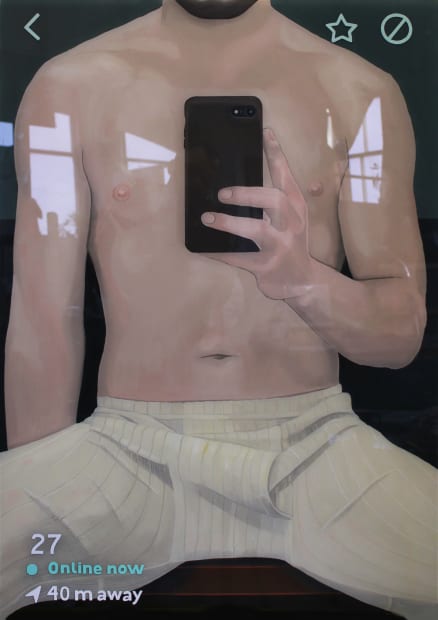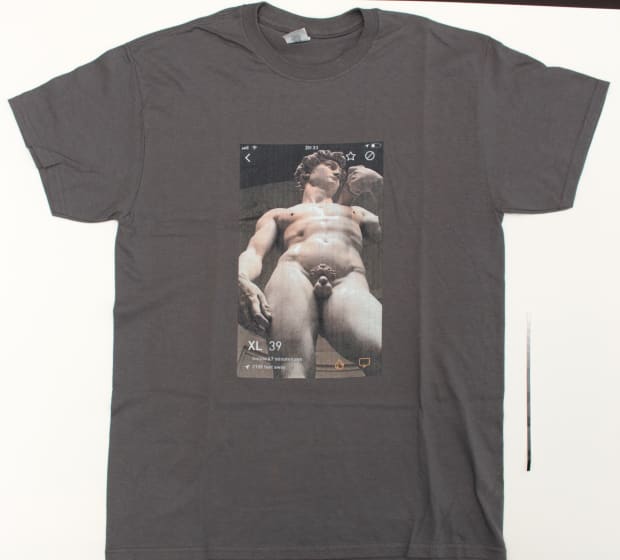-
How did the experience affect you as an individual?
I went to Florence planning on constructing a visual study of the contrasting historical and contemporary representations of the male body. For the historical, traditional ideal form I chose the many Classical and Renaissance oil paintings, frescos, and marble sculptures which ornament the city. In contrast, I decided to explore the profile images on contemporary meeting apps, as they are the realm in which we currently find the most accessible forms of idealised self-portraiture. With this basic structure in mind, I began my research. Very quickly in my study of the historical male nudes throughout Florence, I was delighted to find a wide variety of pieces supportive of queer readings, such as ‘San Sebastiano’ (1842-44) by Pio Fedi and ‘Apollo e Giacinto’ (1768) by Stefano Ricci, both in Palazzo Pitti, and ‘Les bains mystérieux’ (1934-36) by Giorgio de Chirico in Museo Novecento. These works hold a prestigious place in the established canon of queer culture, as James M. Saslow’s work ‘Pictures and Passions: A History of Homosexuality in the Visual Arts ‘ illustrates. Next, upon my first cursory look at the local Florentine profiles on meeting apps, I was surprised to find a somewhat wide-spread habit of users choosing to represent themselves through Classical and Renaissance works; ie posting an image of Caravaggio’s Bacchus instead of a photograph of themselves/ their own body. I feel that this phenomenon creates an immersive experience in a parallel world in which historical ideals and attitudes are merged with contemporary social expectations and interactions. It is here that the evolution of the male form’s ideal is condensed; the historical and contemporary cult of the body meet and meld together. Looking at these Classical images used in such a contemporary context, for a moment I felt trapped in a loop wherein the cause and effect of our values as human beings are not linear, but circular. In the past, artists used models as objects of study for aesthetic, emotional, and scientific communication; today we use these historical communications to represent ourselves in the virtual realm as idealised objects. As a queer artist, the discovery of sort of anthology of queer visual artworks in Florence was quite remarkable and, personally, very moving. This experience helped me to feel connected with my identity as a queer artist, and the legacy of queer artists and subject matter throughout time and space. I am profoundly grateful for my time in Florence, as their particular collection of artworks and the historical and contemporary importance/ popularity of the city allowed me to be at once fully surrounded by history and connected to the current heartbeat of social interaction and artistic innovation.
-

Gregori Mora Pujadas, 27- GLA, oil and sign painting on perspex, 100 x 70 cm
-
These souvenir shops are spaces that offer a seemingly infinite number of products, all presented in series, giving the consumer endless opportunity to choose and obtain. Here is the seed of Neoliberalism; the “ideal” form of unrestricted capitalism. I wanted to compare this mechanism to the marketplace of physical intimacy advertised on the Grindr application, wherein the bodies of the users are presented in a virtual showcase as consumer products. My fieldwork for this project began with an attempt to investigate all possibilities offered by these concepts surrounding the historical and contemporary objectification and commodification of the male body. The consolidation of all these ideas led me to a multidisciplinary project that it would have been all but impossible to imagine before engaging in the aforementioned research. I started using Photoshop to superimpose the photographs of the Queer Renaissance works with a design reminiscent of Grindr profiles. To complete my project, I printed postcards of my images to frame them as cruising memories. In this way, a parallel was established between the objective consumerism of social engagement applications and the constant role of the ideal in capitalism. I then placed these postcards in local souvenir shops throughout the Florence’s city centre in order to create a public representation of the symbolic role of the work within commerce. Thus the project title, ‘My Florence Souvenir’.
-

Gregori Mora Pujadas, My Florence Souvenir, t-shirt David. RSA Collection
-

Gregori Mora Pujadas, My Florence Souvenir. RSA Collection



